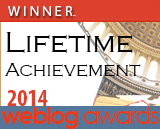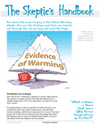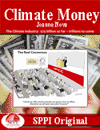|
|
Click to enlarge
We can always rely on Peter Hannam of the Sydney Morning Herald to accidentally advertise the unscientific stars of the Climate Church.
“Spike in global temperature fuels climate change fears”
It used to be that science was symmetrical — the laws of physics worked every day. You know, thou shalt not create nor destroy energy, it’s one of those unarguable things. But UNSW has a new “special” kind of science where the global temperature can pause for years and billions of quadrillions of joules of energy can disappear and who cares? In politically correct science this is noise. But one hot month, caused by an El Nino and strap yourself in, glue on the Armageddon-helmet. Panic-now, Panic-later, Fear and Hellfire. The Mystical Sign has cometh!
Prof Rahmstorf seems a bit confused about what’s “noise” and what’s “signal”:
“It’s important to take this hot spike as a reminder that this is a really urgent problem” said Professor Rahmstorf, who until last week was also a visiting professorial fellow at the University of NSW. “We are running out of time to avoid a 2-degree world.”
Try and imagine him saying […]
In The Age this week, Stephen Sherwood explains how misleading skeptics have been for repeating obvious, incontestable results from millions of weather balloons. See, all along, Sherwood knew the weather balloons were wrong, and if only skeptics had his psychic powers, or connection to God, they would have too. Naughty skeptics,eh?
The article in The Age gives away a lot more than either Steven Sherwood (or Peter Hannam, the Fairfax journalist) probably meant to reveal. Sherwood’s still spruiking his latest study, which repeatedly adjusted and blended the weather balloon data and finally “found” the hot spot so effectively it even shows up in years when it’s not supposed to occur. I’m not talking about his technique, but about his slip of the tongue. Spot the conflicting messages. (As usual, the gullible Peter Hannam let him step right in it, by failing to ask the obvious questions.)
Stephen Sherwood effectively tells four points. Figure out how they can all be true at the same time:
The hot spot is vital to the models, indeed to the current scientific understanding of our climate! This is the first time they have finally resolved the missing hot spot. Sherwood always knew the hot spot […]
Who’s desperate to find the missing hot-spot? Sherwood’s new paper claims to have found it, but after years of multi-layered adjustments, and now kriging the gaps, and iteratively homogenizing, the results of the new data partly “solve” one problem while creating others. There’s no documented, physical reason for the homogenizing and there’s no new insight gained. The raw data was used by airlines, the military, and meteorologists for years, yet the suggested new results are quite different to the raw data. It’s as if we can’t even measure air temperature properly. Somehow we’ve made multivariate complex models work but not simple temperature sensors? The main problem with the old results was that they didn’t fit the models. Now, after torturing the data, they still don’t.
Twenty-eight million weather balloons had shown by 1999 that the key assumption in the climate models was wrong. Without feedbacks, the models only produce 1.2°C of warming with a doubling of CO2. With feedbacks the simulations ramp that up to a dangerous 3 – 4 degrees C, and water vapor was the most important feedback. It’s just no fun for the Global Worriers without it.
No hotspot = no water vapor feedback […]
Guest post by Cohenite
To natural born critics AGW is the gift that keeps giving. It would be cruel to say these papers all exhibit unworldly qualities because that is inevitable if your purpose is to generate a virtual reality with computer modeling. But, as the old saying goes, you have to be cruel to be kind; so some of these papers are speculative and unrealistic; others are eristic and the rest egregious in intent or execution. A scientific theory such as AGW is, like all human endeavours, only as good as its best examples; the following papers, all peer reviewed, represent the best of AGW. The papers are in no particular order, or lack thereof, of merit.
Part I and Part II of The Worst Papers according to Cohenite. Conversely: Ten of the best
8.2 out of 10 based on 5 ratings […]
It’s taken 21 months, four professors, and three associate/assistant professors, and THIS is the best they could come up with? The printed version listed no author (the pdf has been updated with John Cooks name*) yet wears the logo of the University of Western Australia (UWA), which will embarrass that university as word spreads of the intellectual weakness of their “Guide“.
Did UWA commission this piece of rather inept, qualitative “feel-good” science and clumsy reasoning? Stephan Lewandowsky invited John Cook to speak at UWA and “offer assistance“.
The booklet uses a mislabeled graph with a deceptive scale, won’t show the damning graphs it supposedly debunks, assumes positive feedback occurs despite the weight of empirical evidence against it (Douglass, Spencer, Lindzen), and repeats irrelevant information even though The Skeptics Handbook describes why rising sea levels and glaciers and ice sheets can’t possibly tell us what causes the warming. It misleadingly discusses a different fingerprint — one that isn’t the key point and isn’t disputed by skeptics. Cause and effect are mixed up, and naturally there are strawmen arguments to unnecessarily destroy for the spectacle of being seen to do something. To top it off, Cook still thinks a measurement is […]
The line blurs between peer-reviewed-science and peer-reviewed-public-relations.
The Big-Scare-Campaign needed an answer to the missing hot-spot question. They needed to find the “hot spot”, or failing that, at the very least provide a “hot spot” type graph that would answer the critics; something that passed for a scientific answer that might fool journalists and bloggers. The failure to find the projected hot spot is so damning, and so obviously not what the models predicted, that there is a veritable industry of people working hard to find a reason why the weather balloon results must be wrong. Steven Sherwood creatively even resorted to throwing out the thermometer readings entirely and using wind shear instead. (If only we’d known! All those years and we didn’t need the thermometers?)
In Robust Tropospheric Warming Revealed by Iteratively Homogenized Radiosonde Data (March 2008) Sherwood et al combine both windshear and temperature data to reconsider the radiosondes yet again. The Scientific Guide to The Skeptics Handbook and others use the graph from the top left corner of this paper (Fig 1 here) to suggest that the hot spot is not missing, or that the “fingerprint” was found. Sure enough, it’s a cute graph. Looks “hot”, right?
[…]
John Cook might be skeptical about skeptics, but when it comes to government funded committee reports, not so much.
The author of “skeptical science” has finally decided to try to point out things he thinks are flaws in The Skeptics Handbook. Instead, he misquotes me, shies away from actually displaying the damning graphs I use, gets a bit confused about the difference between a law and a measurement, unwittingly disagrees with his own heroes, and misunderstands the climate models he bases his faith on. Not so “skeptical” eh John? He’s put together a page of half-truths and sloppy errors and only took 21 months to do it. Watch how I use direct quotes from him, the same references, and the same graphs, and trump each point he tries to make. His unskeptical faith in a theory means he accepts some bizarre caveats while trying to whitewash the empirical findings.
In the end, John Cook trusts the scientists who collect grants funded by the fear-of-a-crisis and who want more of his money, but he’s skeptical of unfunded scientists who ask him to look at the evidence and tell him to keep his own cash.
These two graphs are not the same […]
Dr Andrew Glikson (an Earth and paleoclimate scientist, at the Australian National University) contacted Quadrant offering to write about the evidence for man-made global warming. Quadrant approached me asking for my response. Dr Glikson replied to my reply, and I replied again to him (copied below). No money exchanged hands, but Dr Glikson is, I presume, writing in an employed capacity, while I write pro bono. Why is it that the unpaid self taught commentator needs to point out the evidence he doesn’t seem to be aware of? Why does a PhD need to be reminded of basic scientific principles (like, don’t argue from authority). Such is the vacuum of funding for other theories that a debate that ought to happen inside the university obviously hasn’t occurred. Such is the decrepit, anaemic state of university science that even a doctorate doesn’t guarantee a scientist can reason. Where is the rigor in the training, and the discipline in the analysis?
Credibility lies on evidence
by Joanne Nova
April 29, 2010
Reply to Andrew Glikson
Dr Andrew Glikson still misses the point, and backs his arguments with weak evidence and logical errors. Instead of empirical evidence, often […]
Big names like Santer, Sherwood, and Schmidt admit that the models predict more warming 10 km above the equator than what the weather balloons could find. Each time they announce that they’ve resolved the differences, they have to start by admitting there are differences to resolve. […]
The ‘Hotspot’ is crucial to the climate debate.
If greenhouses gases are warming the planet that warming will happen first in the cold blob of air 8-12 km above the tropics. It’s freezing cold up there, but it ought to be slightly less freezing cold thanks to greenhouse gases. All 20-odd climate models predict warming there first—it’s the fingerprint of greenhouse gas warming, as opposed to warming by some other cause, like solar magnetic effects, volcanic eruptions, solar irradiance, or ozone depletion etc etc.
Look at A above, the greenhouse gas fingerprint is markedly different from the rest and dominates the overall predicted pattern in graph F. The big problem for the believers of AGW is that years of radiosonde measurements can’t find any warming, as shown in part E of Figure 5.7 in section 5.5 on page 116 of the US CCSP 2006 report
8.7 out of 10 based on 38 ratings […]
|
JoNova A science presenter, writer, speaker & former TV host; author of The Skeptic's Handbook (over 200,000 copies distributed & available in 15 languages).

Jo appreciates your support to help her keep doing what she does. This blog is funded by donations. Thanks!


 Follow Jo's Tweets
Follow Jo's Tweets To report "lost" comments or defamatory and offensive remarks, email the moderators at: support.jonova AT proton.me
Statistics
The nerds have the numbers on precious metals investments on the ASX
|












Recent Comments